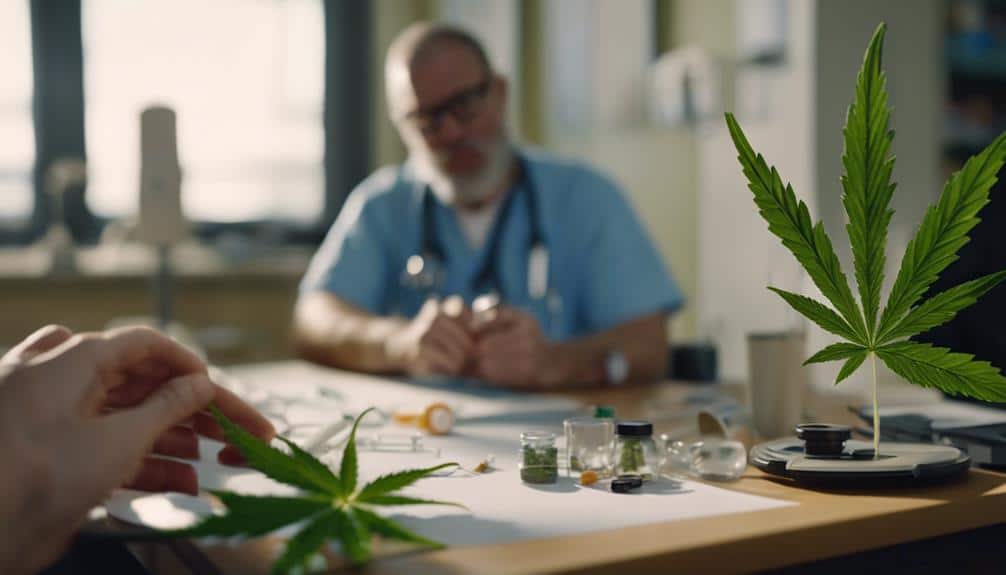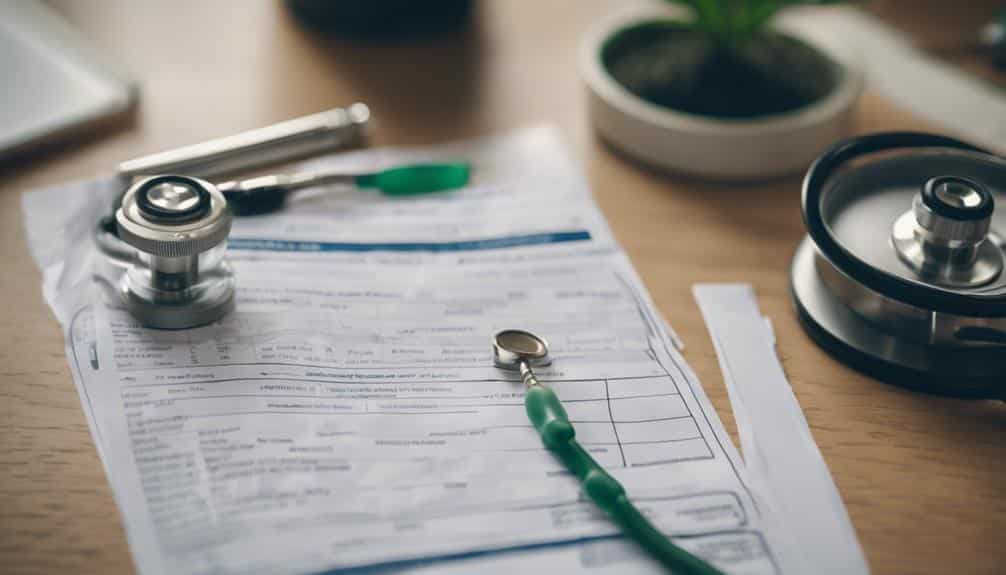Did you know that over 60,000 Maryland residents are currently registered with the state’s medical marijuana program? If you’re considering this option, you might have a lot of questions. You could be curious about the benefits, potential side effects, or how it could interact with your current medications. Let’s start a conversation about medical marijuana, its impact on your health, and why it’s essential to discuss this with your healthcare provider. Stay tuned to find out more.
Understanding Medical Marijuana

Firstly, it’s important to understand that medical marijuana or cannabis is a plant-based medicine from the Cannabis sativa or Cannabis indica species. It has three major active compounds: THC, CBD, and CBN.
The strains of Cannabis differ in their THC and CBD concentrations which affect the medicinal benefits and potential side effects. THC (tetrahydrocannabinol) holds psychoactive properties providing the ‘high’. CBD (cannabidiol) possesses therapeutic benefits without intoxicating effects. CBN (cannabinol) contributes to the sedative effect in some strains.
Patient eligibility for medical marijuana varies by state and condition. Common qualifying conditions include chronic pain, multiple sclerosis, nausea from chemotherapy, and certain seizure disorders. However, it’s not a one-size-fits-all solution. While one strain might alleviate symptoms for one patient; it may not work similarly for another. Understanding various strains and their effects is a crucial part of the conversation with your healthcare provider.
Legal Status in Maryland
Before exploring specific strains and their effects, it’s important to consider the legalities of medical marijuana, particularly if you’re residing in Maryland. Maryland regulations allow for the use of medical marijuana for patients with a valid prescription from a registered healthcare provider. This allows those with certain chronic conditions to access this alternative treatment method legally.
The prescription process in Maryland requires navigating through several steps. It’s not as simple as getting a prescription for other medications. You must first register with the Maryland Medical Cannabis Commission (MMCC), which involves providing proof of Maryland residency and valid identification. Then, you’ll need a written certification from an MMCC-registered provider confirming that you have a qualifying condition.
Potential Health Benefits

Despite the legal hurdles, an array of potential health benefits makes medical marijuana a compelling treatment option for many patients. Here, we’ll delve into the therapeutic applications of medical marijuana, specifically focusing on cannabinoid therapies.
- Pain Management: Medical marijuana can alter pain perception pathways in your brain offering relief from discomfort. It’s particularly effective in treating chronic pain often outperforming traditional medications.
- Neurological and Mental Disorders: Conditions like epilepsy, multiple sclerosis, and PTSD have shown marked improvements with the use of medical marijuana. The cannabinoids interact with receptors in your brain to reduce symptoms and improve quality of life.
- Appetite Stimulation and Nausea Reduction: For those undergoing treatments like chemotherapy, marijuana can help alleviate nausea and stimulate appetite improving overall nutritional intake and health.
- Sleep Disorders: If you’re struggling with conditions such as insomnia, medical marijuana might provide a solution. It aids in regulating sleep patterns promoting restful and sustained sleep.
Through these applications, it’s clear that the health benefits of medical marijuana are significant. When paired with professional medical guidance, cannabinoid therapies can be a powerful tool for managing various health issues. Remember, it’s vital to have open discussions with your healthcare provider to consider all potential benefits and risks.
Possible Side Effects
While medical marijuana can offer significant benefits, it’s important to be aware of potential side effects that might impact your health. Like any medication, its effects can vary based on factors such as your physical condition, the strain of marijuana used, and the dosage.
Dosage concerns are a prime consideration. Start with a low dose and monitor your body’s response. Overdosing can lead to uncomfortable or even harmful side effects like dizziness, paranoia, and rapid heart rate. Be mindful of the potential for developing tolerance which may lead to increased dosage over time often exacerbating side effects.
Equally important is considering allergic reactions. Just as with any plant-based product you could have an allergic response to medical marijuana. Symptoms can range from skin irritations to more severe responses such as difficulty breathing. It’s vital to monitor your body’s reaction and communicate any unusual symptoms to your healthcare provider.
Preparing for the Discussion

To prepare for a discussion with your healthcare provider about medical marijuana, it’s essential to gather comprehensive factual information and articulate any personal concerns or questions you may have. Overcoming your discussion fears is possible and can be achieved by being well-prepared and open-minded.
Here are four steps to help you prepare for the conversation:
- Research: Understand the potential benefits and risks associated with medical marijuana. Use reliable sources like medical journals, health websites, and government health agencies.
- List Your Concerns: Make a note of any personal concerns or symptoms you hope to alleviate. This could include chronic pain, anxiety, or insomnia.
- Conversation Approach: Decide how you’d like to initiate the conversation. You might say ‘I’ve been looking into alternative treatments and I’d like to discuss the potential of using medical marijuana.’
- Prepare for Questions: Anticipate possible questions from your provider. They might ask about your current medications, your lifestyle, or your previous experience with marijuana.
Talking Points to Consider
Having prepared yourself for the discussion let’s consider some key talking points to effectively communicate with your healthcare provider about medical marijuana. Your conversation should be open honest and focused on your health needs and personal concerns.
Firstly focus on prescription alternatives. As you know medical marijuana can serve as an alternative to traditional medications. Discuss the prescriptions you’re currently taking and how medical marijuana might interact with or replace them. This conversation can help your provider understand your current health status and guide you towards the safest most effective treatment.
Secondly address your personal concerns about medical marijuana. Whether you’re worried about potential side effects addiction or social stigma voice these concerns to your provider. You might also have questions about legality access and cost. Don’t hesitate to ask them. Remember, your provider is there to help not judge.
Lastly discuss your goals for using medical marijuana. Are you seeking pain relief reduced anxiety or better sleep? Your goals will impact your treatment plan so make sure your provider understands what you’re hoping to achieve.
Next Steps After Consultation

Once you’ve had a thorough discussion with your healthcare provider about medical marijuana it’s crucial to understand the next steps in your journey towards potential treatment. Here’s what you need to know:
- Treatment Duration: This isn’t a one-size-fits-all situation. Your provider will guide you in determining the appropriate length of time for treatment considering factors like health condition lifestyle among others.
- Dosage Adjustments: Over time, adjustments may be needed in dosage based on body response which should be promptly reported to the healthcare provider.
- Follow-up Consultations: Regular check-ins with healthcare providers are vital for monitoring progress addressing any side effects and making necessary adjustments.
- Legalities: Ensure you’re abreast with Maryland’s medical marijuana laws. This includes knowing how to legally obtain and use medical marijuana for your treatment.
Conclusion
Navigating the waters of medical marijuana can be tricky but with open dialogue, it’s smooth sailing. Remember, your Maryland healthcare provider is your partner in this journey. Discussing medical marijuana and its potential benefits side effects and legal status is key. Don’t beat around the bush – be clear about your symptoms and concerns. The goal is a personalized treatment plan that fits like a glove. With your provider’s guidance, you’ll be on the right path.
I warmly invite you to visit us at Fells Point Cannabis Docs of Maryland to learn more about how medical marijuana could help you. We’re here to provide all the information you need to make an informed decision. And hey if you have any questions or just want to chat don’t hesitate to give us a call. We’re here for you, and we’d love to be part of your journey towards better health.

